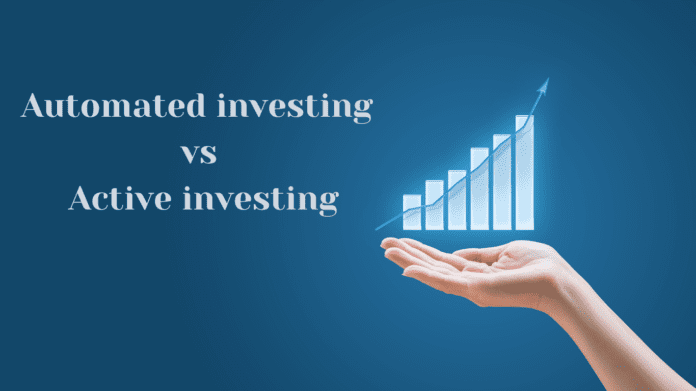Investing in the digital age has become more accessible than ever before. With advancements in technology, individuals now have various options to choose from when it comes to investing their hard-earned money. This article will explore automated investing vs active investing vs passive investing. By understanding the pros and cons of each approach, you will be better equipped to make informed decisions about your investments.
What is automated investing?
Automated investing, also known as robo-advisory, combines the benefits of technology and human expertise. Automated investing, also known as robo-advising, has recently gained significant popularity. This strategy involves leveraging cutting-edge technology and algorithms to manage investment portfolios. Essentially, it is an automated platform that provides investors with a streamlined and hassle-free investment experience. These platforms typically utilize risk tolerance, financial goals, and time horizon to create a diversified portfolio tailored to the individual’s needs. It is a form of passive investing wherein algorithms and computer programs automatically manage and rebalance an investor’s portfolio.
What is active investing?
Active investing involves proactive decision-making and constant monitoring of the market. Unlike automated investing, active investing involves a hands-on portfolio management approach. These individuals aim to outperform the market by leveraging their expertise and taking advantage of short-term market fluctuations.
Active investing gives investors a sense of control and the opportunity to capitalize on market trends. However, it requires a significant time commitment and a deep understanding of the financial markets. Moreover, active investing often incurs higher fees, as it may involve the services of financial advisors or brokers. Investors who follow this approach aim to outperform the market by buying and selling securities according to their analysis and predictions.
What is passive investing?
Lastly, passive investing involves a more hands-off approach. Passive investing is a method that tries to go after and mimic the performance of a market index by keeping a portfolio of securities that is composed and weighted similarly to the index. Investors can trade ETFs on stock exchanges like stocks, making them a convenient and popular choice for passive investing. These vehicles provide diversified, low-cost, and transparent access to various indexes.

Automated investing vs Active investing:
Automated investing vs active investing are similar but different. Automated investing relies on algorithmic computer models for investment decisions, while active investing relies on judgement, search and analysis to make investment decisions. Additionally, while automated investing analyzes large amounts of data, and trades are made through predetermined rules, it’s more systematic and tends to reduce the need for human emotion from investments. On the other hand, active investing is a more subjective hands-on approach.

Automated investing vs active investing requires varying approaches from the investor. Automated investing is a better hands-off approach, while active investing requires a time commitment from investors. Diversification is big in automated investing, as investors allocate their investments across stocks, bonds, and commodities. Active investors have more control over asset allocation since they may alter their portfolios based on market circumstances and research.
Automated investing vs Passive investing:
Automated investing vs passive investing differ in their approach. While passive investing focuses on buying and holding a diversified portfolio that mimics an extensive market index, such as the S&P 500. The idea is to equal market returns rather than exceed them.
Automated investment platforms often offer cheaper costs compared to actively managed funds. Their automated nature enables cost-effective operations, resulting in decreased expenses for investors. Like active investing, passive investing offers cheaper fees since it requires less trading and research. When assessing investing methods, performance is an essential factor to consider. While active investing aims to exceed market performance, several studies have indicated that most actively managed funds have difficulty in consistently outperforming their benchmark indexes in the long run. Passive investment, conversely, aims to replicate market performance, which is a more constant and predictable strategy.
Automated investing vs active investing vs passive investing carry different levels of risk. Active investing holds the highest percentage of risk when compared to the others. Active investors take responsibility for portfolio management, creating potential for human mistakes and emotional decision-making. By definition, automated and passive investing seeks to reduce risk through diversification and adherence to predefined investment plans.
Pros and cons of automated investing:
Automated investing combines the benefits of passive investing with the efficiency of technology. One of the main advantages of automated investing is its accessibility. With robo-advisors, investors can start investing with relatively small amounts of money. Additionally, automated investing offers a hands-off approach. The algorithms and computer programs automatically manage the investor’s portfolio, making it ideal for those with limited time or knowledge about investing.
Moreover, automated investing provides a disciplined investment strategy. Emotions and biases often affect investment decisions and are eliminated, resulting in a more rational and systematic approach. However, automated investing also has its disadvantages. The reliance on algorithms means it may be unable to adapt to unforeseen market conditions. Additionally, investors may not have control over specific investment decisions, as the robo-advisor makes them.
Pros and cons of active investing:
Active investing offers several advantages. One of the main benefits is the potential for higher returns. Since active investors actively seek opportunities, they can capitalise on market inefficiencies and generate alpha. Additionally, active investors have greater control over their investments. Individuals can swiftly make decisions to capitalise on market trends and adjust their strategies accordingly.
However, active investing also comes with its drawbacks. Researching, analysing, and monitoring investments requires significant time and effort. Moreover, active investing often incurs higher costs due to frequent trading and management fees. Lastly, it is essential to note that even the most skilled active investors cannot guarantee consistent outperformance in the market.
Pros and cons of passive investing:
Passive investing has gained popularity recently due to its simplicity and lower costs. Passive investing has the significant benefit of providing broad market exposure. Investors can acquire exposure to diverse assets by investing in index or exchange-traded funds (ETFs). This reduces risk and allows you to invest in various assets.
Passive investing also offers lower costs than active investing since it involves minimal buying and selling. Additionally, passive investing requires less time and effort as it does not require constant monitoring. However, passive investing also has its limitations. Since the goal is to match the performance of the market, passive investors will not outperform it. This means they may miss out on potential opportunities for higher returns. Moreover, passive investing offers less flexibility as investors are bound to the performance of the chosen market index.
Comparing – Automated Investing vs Active Investing vs Passive Investing:
After analysing the advantages and disadvantages of the investment strategies, it’s time to compare them. Active investing presents the possibility of greater profits, but it demands a considerable amount of time, energy, and proficiency. Passive investing provides broad market exposure and lower costs but does not outperform the market. Automated investing combines the benefits of passive investing and technology, offering accessibility and a disciplined investment strategy, but it may lack flexibility and control. These approaches ultimately depend on your financial goals, risk tolerance, and investment preferences.
Examples of successful automated investing strategies
Automated investing has gained popularity recently, and numerous successful strategies have emerged. One example is using robo-advisors that offer personalised portfolios based on an investor’s goals and risk tolerance. These algorithms consider age, income, and time horizon to create a diversified portfolio. Another successful strategy is the use of automated rebalancing. By regularly rebalancing the portfolio, investors can maintain their desired asset allocation and minimise risk. Additionally, tax-loss harvesting is another strategy used in automated investing. This method involves selling securities at a loss to offset capital gains while reducing tax liabilities.
Examples of successful active investing strategies

Active investing requires skill, knowledge, and constant monitoring of the market. Successful active investors often employ various strategies to outperform the market. One example is value investing, where investors search for undervalued stocks trading lower than their intrinsic value. Another successful strategy is growth investing, where investors focus on stocks with high growth potential. Active investors also utilise technical analysis, which involves studying price patterns and trends to make investment decisions. Active investors often use sector rotation to allocate their investments to sectors they predict will perform better than the overall market.
Examples of successful passive investing strategies
Passive investing aims to mimic the performance of a specific market index. One successful strategy is investing in low-cost index funds or ETFs that track well-known indices such as the S&P 500 or the FTSE 100. These funds provide instant diversification across a wide range of stocks. Another successful strategy is dollar-cost averaging, where investors regularly invest a fixed amount of money into their portfolio, regardless of market conditions. Using this strategy, investors can benefit from market fluctuations and minimise the impact of short-term market volatility. Additionally, a buy-and-hold strategy, where investors hold onto their investments for the long term, is another popular passive investing approach.
The future of investing in 2024:
As we look to the future, it is clear that technology will continue to play a significant role in investing. Automated investing will become even more prevalent with artificial intelligence and machine learning advancements. Robo-advisors may offer even more sophisticated algorithms, providing investors with highly personalised and efficient investment strategies. Furthermore, the rise of cryptocurrencies and blockchain technology may revolutionise the investment landscape, offering new opportunities for investors. Investors must stay informed about these developments and adapt their investment strategies accordingly.
Conclusion – Investing in 2024:
In conclusion, investing in the digital age offers various active, passive, and automated options. Each approach has pros and cons, and the right one for you depends on your financial goals, risk tolerance, and investment preferences. Investing actively has the possibility of yielding higher returns, but it demands a considerable amount of time and effort.
Passive investing provides broad market exposure and lower costs but does not outperform the market. Automated investing combines the benefits of passive investing and technology, offering accessibility and a disciplined investment strategy. As you navigate the world of investing, take the time to evaluate your options and choose an approach that meets your financial goals. Investing is a long-term journey, and making informed decisions is key to success.




